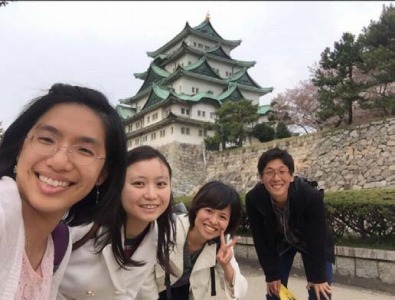Clinical Exchange in Japan
Welcome to Japan and Nagoya University school of Medicine!
Experience Report
Liyang Tang from Johns Hopkins School of Medicine
Period:2016/3/28 – 2016/4/15
Department: Gastroenterological Surgery 2 and Otorhinolaryngology
I went to Nagoya University as a third year student to learn about gastric and squamous cell esophageal carcinomas, but this clinical experience has taught me much more. I learned about the challenges of living in a country where I neither knew the language nor the culture and experienced how hospitable and kind Japanese people are. On my first day, I could not figure out how to get out of the hospital, so I stopped a passerby to ask for directions. She walked me all the way to the subway station even though it was in the opposite direction of where she was headed.
I first rotated through gastroenterological surgery 2, where I observed laparoscopic esophagectomies, gastrectomies, and pancreatectomies. The surgeons explained every step of each procedure. We went over anatomy, cancer staging, and why we were doing each operation. Although there was a language barrier, they patiently answered all of my questions and made sure I understood by drawing pictures and using a translator. I also attended simulation sessions with the sixth year Japanese students. Dr. Takami patiently taught me how to tie laparoscopic knots and Dr. Hayashi walked me through a laparoscopic cholecystectomy in a simulation case. Additionally Professor Kodera took time to teach me all about gastric cancer management and answered my questions regarding the Japanese health care system and its inner workings. I was overwhelmed by how kind and welcoming everyone in the department was.
I then rotated through the otorhinolaryngology department, where I scrubbed in on several of the head and neck cancer cases and attended tumor board. Again, the surgeons patiently explained all the surgeries and made sure I understood their descriptions. They even did their case conference in English! Additionally, I was impressed by the variety of cases performed, from a laryngeal diversion to prevent aspiration in an ALS patient to endoscopic mucosal resection for hypopharyngeal squamous cell dysplasia. I also attended a temporal bone drilling simulation session with the fifth year Japanese students and learned how easy it is to injure important structures nearby. I am extremely grateful to everyone in both the gastroenterological surgery 2 and otorhinolaryngology departments for being so patient and for translating all the explanations for me.
On the weekends, I visited the three historical or current capitals of Japan: Nara, Kyoto, and Tokyo. I went to Kyoto when the cherry blossoms were in peak bloom. The scenery along the Tetsugaku-no-michi (Philosopher’s Walk) was breathtaking – pink blossoms lining a canal. So much of Japanese culture and history is also embedded in Kyoto and I was fortunate enough to participate in a tea ceremony, visit Zen Buddhist temples, and walk around Gion.
Through this clerkship, I have a better understanding of what it is like to have a communication barrier, whether it is due to language misunderstandings, cultural differences, or hearing impairment, and learned to be a more empathetic, patient person. I also had the opportunity to learn about the unique culture of this beautiful island nation and would like to thank all the medical students and doctors who took me out to try various Japanese dishes from Hiroshima Okonomiyaki to Unagi! Thank you to everyone at Nagoya and Hopkins for making this rotation happen! It was a lovely experience.

Nagoya Castle
Click here to read other stories
Nagoya University Graduate School of Medicine